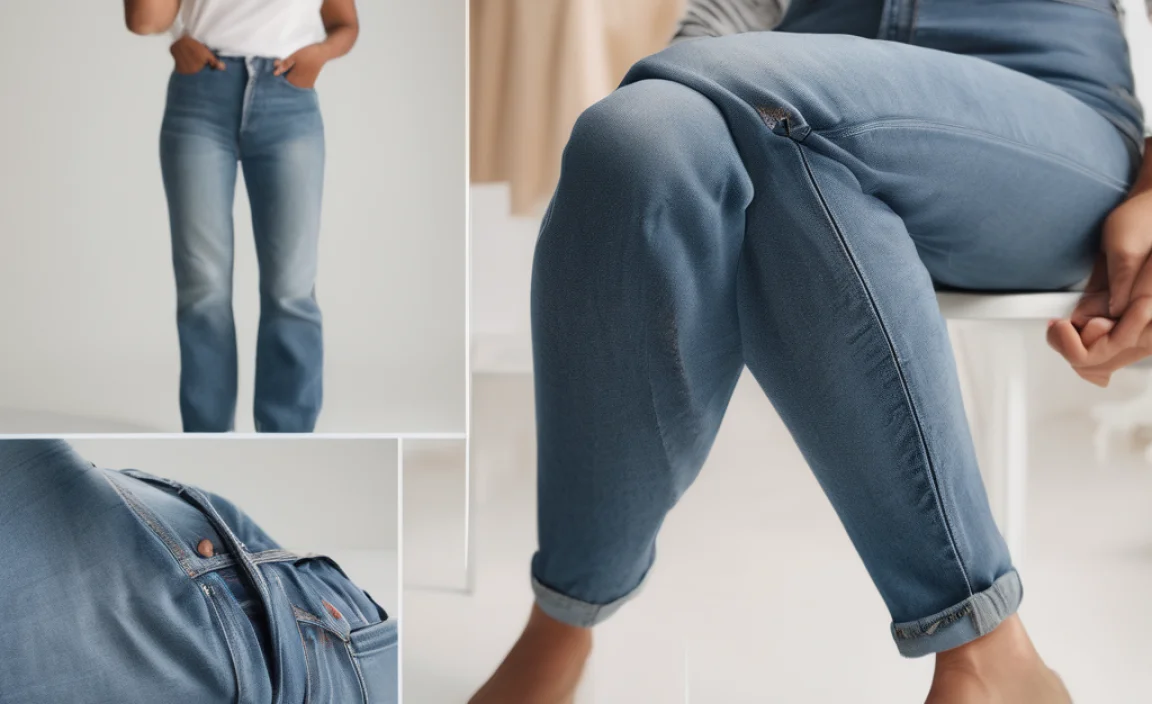Quick Summary: Yes, you can easily hem mom jeans without sewing! This guide shows you how using simple tools like fabric tape or hemming clips for a clean, custom fit in minutes. Get that perfect cropped look quickly and affordably.
Mom jeans are a classic for a reason, but sometimes the length just isn’t quite right. Maybe they’re a little too long, or you want to tap into the trendy cropped style. The good news is you don’t need a sewing machine or even basic sewing skills to achieve a neat hem. This guide will walk you through simple, no-sew methods that are quick, easy, and give your favorite denim a fresh, customized look in no time. We’ll cover everything from the best tools to common mistakes to avoid, so you can confidently rock your perfectly hemmed mom jeans.
Why Hem Mom Jeans Without Sewing?

Many of us love the retro vibe and comfortable fit of mom jeans, but their original length might not always be ideal for our footwear or personal style. Constantly wearing jeans that are too long can make you look shorter, and they can drag on the ground, getting dirty and potentially damaged. While traditional hemming by a tailor is an option, it can be costly and time-consuming. Fortunately, there are several effective no-sew methods that allow you to adjust the length of your mom jeans quickly and affordably. These techniques are perfect for beginners or anyone who needs a fast fix.
Assess Your Mom Jeans and Desired Length

Before you grab any tools, take a moment to properly assess your mom jeans and decide exactly how you want them to look. This planning stage is crucial for a successful no-sew hem.
1. Try Them On with Your Intended Shoes
The length of your jeans can look very different depending on the shoes you plan to wear them with. Try on your mom jeans with the exact shoes (or at least shoes of a similar heel height) you envision wearing them with. This helps determine the most flattering hemline for a specific look.
2. Mark Your Desired Length
Once your jeans are on and you’re wearing the right shoes, stand in front of a mirror. Use a fabric pencil, chalk, or even a piece of scrap fabric to mark where you want the hem to fall. You can do this by:
- Gently folding the excess fabric upwards to the desired length and marking the edge.
- Using a measuring tape held against your leg from the crotch seam outwards.
- Asking a friend to help you mark an even line around the entire leg.
It’s often a good idea to mark a little longer than you think you need initially, as you can always trim more later. Aim for a clean, straight line, or consider a slightly angled hem for a modern touch.
3. Consider the Original Hem
Mom jeans often have a distinct, thicker hem. When no-sewing, you have a few options:
- Cut off the original hem: This gives you a clean, raw edge, which is very trendy.
- Recreate a faux hem: You can use fabric glue or tape to fold the fabric back on itself, mimicking a traditional hem.
- Leave the original hem: If you’re just shortening them slightly, you might be able to hide the excess fabric above the existing hem.
Understanding what kind of finish you want will guide your choice of method.
No-Sew Hemming Methods: Step-by-Step

Here are the most effective and beginner-friendly ways to hem your mom jeans without a single stitch.
Method 1: Fabric Fuse Tape / Hemming Tape
This is one of the most popular and reliable no-sew hemming techniques. Fabric fuse tape, also known as hemming tape or hem tape, is a fusible adhesive that melts when ironed, bonding two pieces of fabric together.
What You’ll Need:
- Fabric fuse tape (available at craft stores or online)
- Iron and ironing board
- Scissors (fabric scissors are best)
- Fabric pencil or chalk (for marking)
- A damp cloth or parchment paper (optional, to protect your iron)
Steps:
- Prepare Your Jeans: Ensure your jeans are clean and dry. Lay them flat on your ironing board.
- Mark and Cut (Optional): If you’re cutting off the original hem for a raw edge, do that first. Mark your desired hemline with a fabric pencil or chalk, and carefully cut along the line, leaving about 1-2 inches of extra fabric for folding if you plan to create a folded hem.
- Fold the Fabric: For a folded hem, fold the bottom edge of the jean leg upwards by about 1/2 inch, and press lightly with the iron to create a crease. Then, fold it up again by the width of your hemming tape (usually about 1/2 inch to 1 inch), aligning it with your desired finished hem length. Press firmly to create a crisp fold.
- Insert the Hemming Tape: Unfold the second fold slightly. Cut a piece of fabric fuse tape to fit the length of the hem you’re working on. Slide the tape between the two layers of fabric, ensuring it sits evenly against the folded edge.
- Iron to Fuse: Place a damp cloth or parchment paper over the hem to protect your iron (check the tape’s instructions). Set your iron to the appropriate heat setting for denim (usually cotton, medium to high heat, no steam – check your tape manufacturer’s recommendations). Press the iron firmly onto the taped area for the duration recommended by the tape manufacturer (typically 8-15 seconds). Ensure you iron both the front and back sides of the hem to create a strong bond.
- Repeat and Inspect: Repeat the process for the other leg. Once cooled, gently tug on the hem to ensure it’s securely attached. If any parts feel loose, re-iron them.
Pros & Cons of Hemming Tape:
| Pros | Cons |
|---|---|
| Strong, durable bond | Requires an iron |
| Creates a clean, finished look | Can be slightly stiff |
| Relatively inexpensive | Permanent bond (hard to undo) |
| Easy to use for beginners | May require multiple ironing passes |
Method 2: Fabric Glue
Fabric glue is another excellent no-sew alternative. It’s a flexible adhesive that dries clear and forms a strong bond between fabrics. This method is great for a quick fix or for creating a raw hem effect.
What You’ll Need:
- Permanent fabric glue (e.g., Aleene’s Fabric Fusion, fabric Tac)
- Fabric pencil or chalk
- Scissors
- Clothespins or binder clips
- A heavy book or flat object (for pressing)
Steps:
- Prepare Your Jeans: Wash and dry your jeans. Lay them flat.
- Mark and Cut: Mark your desired hemline and cut off any excess fabric, leaving about 1 inch if you want to create a folded hem. For a raw hem, you can cut directly to your desired length.
- For a Folded Hem: Fold the bottom edge up by about 1/2 inch and press to create a crease. Then fold it up again to your desired finished hem length. Secure this fold with clothespins or binder clips.
- Apply Glue: Carefully run a bead of fabric glue along the inside edge of the folded hem, ensuring it touches both layers of fabric. Or, if creating a raw hem, apply a thin line of glue just above the cut edge on the inside of the fabric to prevent fraying.
- Press and Hold: Press the folded hem down firmly, or ensure the raw edge is secure. Use the clothespins/clips to hold everything in place while the glue dries. You can also place a heavy book on top of the hem for even pressure.
- Cure Time: Allow the fabric glue to cure completely according to the manufacturer’s instructions. This can take anywhere from a few hours to 24 hours. Once dry, remove the clips. For raw hems, you might want to gently fray the edge before the glue fully cures.
Pros & Cons of Fabric Glue:
| Pros | Cons |
|---|---|
| Flexible bond | Drying time can be lengthy |
| Great for detailed work or embellishments | Can be messy if not applied carefully |
| Works well for raw hems | May not hold up to very heavy wear or frequent washing as well as tape |
| No iron required | Can be more expensive over time than tape |
Method 3: Iron-On Hemming Webbing (No Glue)
This is similar to hemming tape but specifically designed to be activated by heat, sometimes without needing glue. It creates a firm hem that’s durable enough for denim. Always check product instructions as they can vary.
What You’ll Need:
- Iron-on hemming webbing
- Iron and ironing board
- Scissors
- Fabric pencil or chalk
Steps:
- Prepare: Wash and dry jeans, lay them flat.
- Mark and Fold: Mark your desired hem length. Fold the fabric up twice, as you would with hemming tape, to create the desired finished length. Secure with pins or firm creases.
- Cut Webbing: Cut the hemming webbing to the desired length.
- Position Webbing: Unfold the second fold of the fabric slightly so you can insert the hemming webbing between the two layers. Make sure it’s centered.
- Iron: Following the manufacturer’s instructions (usually medium-high heat, no steam), press the iron firmly over the hem for the recommended time (often around 10-15 seconds per section). Ensure it covers the entire area where the webbing is placed.
- Repeat: Do the same for the other leg. Let cool completely before testing the strength of the hem.
Pros & Cons of Hemming Webbing:
| Pros | Cons |
|---|---|
| Strong hold similar to tape | Requires an iron |
| Durable for denim | Less flexible than glue |
| Quick application once you get the hang of it | Can be slightly bulky |
| Clear instructions usually provided | Permanent bond |
Method 4: Fabric Tape (Double-Sided Adhesive)
This is a strong, double-sided adhesive tape specifically designed for fabric. It doesn’t require heat, making it a super quick option.
What You’ll Need:
- Strong, permanent double-sided fabric tape (e.g., Stitch Witchery, HeatnBond Ultrahold)
- Fabric pencil or chalk
- Scissors
- Clothespins or binder clips
Steps:
- Prepare Jeans: Lay your clean, dry jeans flat.
- Mark and Fold: Mark your desired hem length. Fold the bottom edge up by about 1/2 inch, press to crease. Fold again to your desired finished hem length. Secure with clips.
- Apply Tape: Peel the backing off one side of the double-sided fabric tape. Carefully apply it along the inside edge of the folded hem, pressing down firmly.
- Peel and Press: Peel the second backing off the tape. Press the raw edge of the fabric firmly onto the adhesive. This method might involve folding the fabric over and applying the tape on the raw edge, then pressing that edge against the inner folded fabric. Read your tape’s specific instructions.
- Secure and Wear: Ensure the tape adheres well. You can add clips for extra security if needed. Some tapes require a short curing time; check the packaging before washing.
Pros & Cons of Double-Sided Fabric Tape:
| Pros | Cons |
|---|---|
| No iron required | Hold strength can vary; some may not be permanent |
| Very fast application | Can be less durable than fused tape or glue over time and many washes |
| Good for quick fixes and temporary hems | Some tapes can leave a slightly stiff feel |
| Accessible and easy to find | May require reapplication after washing/wear |
Creating a Raw Hem Finish

A raw hem is a popular look for mom jeans, offering a casual, slightly distressed vibe. It’s one of the easiest no-sew hemming techniques.
What You’ll Need:
- Sharp fabric scissors or a seam ripper
- Fabric pencil or chalk
- Optional: Fabric glue or fray check liquid
Steps:
- Try On and Mark: Put your jeans on with your desired shoes. Mark your target hem length with a fabric pencil or chalk.
- Cut the Jeans: Carefully cut off the excess fabric along your marked line. It’s better to cut slightly longer than you think you need, as you can always trim more. A sharp pair of fabric scissors will give a cleaner cut. For a more authentic look, you can use a seam ripper to carefully remove the original hem stitching, then cut the fabric slightly above where the original hem sat.
- Prevent Excessive Fraying (Optional but Recommended): To control how much the jeans fray, you have a few options:
- Fabric Glue: Apply a thin line of permanent fabric glue along the inside of the cut edge. This will stop fraying at that precise point.
- Fray Check Liquid: Apply a clear liquid like Fray Check around the cut edge. This seals the fabric fibers.
- Washing Technique: Wash and dry your jeans as usual. The edges will naturally fray. You can then trim any excessively long threads.
- Distress Further (Optional): For a more worn look, you can gently rub the cut edge with sandpaper or a pumice stone to encourage more fraying.
A raw hem is great because it’s so forgiving. The imperfect nature of the fraying means you don’t need a perfectly straight cut.
Tips for the Perfect No-Sew Hem

Achieving a professional-looking hem without sewing is entirely possible with these key tips:
- Read Instructions: Always read and follow the specific instructions for your chosen hemming product (tape, glue, etc.). Heat settings on irons, drying times, and application methods can vary significantly. For instance, the HeatnBond website offers detailed instructions for their products often used in no-sew projects.
- Pre-Wash Your Jeans: Always wash and dry your jeans before hemming. This pre-shrinks the denim and removes any finishes that might interfere with the adhesive or tape.
- Measure Twice, Cut Once: Be precise when marking your desired length. It’s much easier to trim off a little more than to add it back.
- Iron on a Flat Surface: Use a sturdy, flat ironing board. uneven surfaces can lead to uneven heat application.
- Press Firmly and Evenly: When using heat-activated products, apply consistent pressure with your iron.
- Allow Full Cure Time: Be patient! If using fabric glue or certain tapes, let them cure for the recommended time before putting them to the test or washing them.
- Consider Denim Weight: Thicker, stiffer denim may require more heat, pressure, or a stronger adhesive than thinner denim.
- Test on a Scrap Piece: If you’re unsure, cut a small scrap from the excess fabric you trimmed off and test your hemming method on that piece first.
Common Mistakes to Avoid
Even with the simplest methods, a few missteps can affect the outcome. Here’s what to watch out for:
- Not Trying On with Shoes: Hemming without your intended footwear can lead to an awkward length that doesn’t work with your outfit.
- Cutting Unevenly: While raw hems are forgiving, a poorly cut folded hem can look unprofessional. Use a ruler or guide if needed.
- Skipping the Cre











